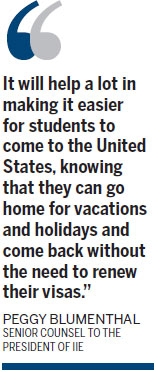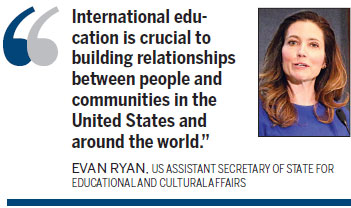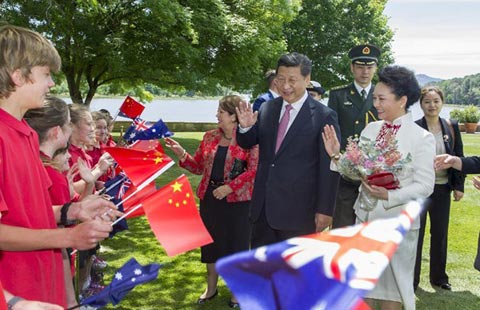China sends record number to study in US
Updated: 2014-11-18 13:12
By Chen Weihua in Washington(China Daily USA)
|
||||||||
Chinese students have accounted for a growing percentage of international students in US universities and colleges, according to a report released Monday by the Institute of International Education (IIE).
Overall, the 273,439 Chinese mainland students in US universities and colleges during the 2013/14 academic year represent a 16.5 percent increase over the previous year. They account for 31 percent of all 886,052 international students in the US.
It is the fifth consecutive year that the Chinese mainland has retained the top place, after seven years of double-digit percentage increases. There are five times as many Chinese mainland students on US campuses as were recorded in the Open Doors Report on International Education Exchange 2000.
However, that growth rate has been the lowest since 2008/09, largely due to slower growth at the graduate level.
With increasing living standards, more Chinese parents can afford to send their children, often the only one in the family, for undergraduate education abroad. The US has seen an upsurge of undergraduate students from the Chinese mainland. They account for 40.3 percent of the total Chinese mainland students.
If the number of students from Hong Kong, Macao and Taiwan were combined as a whole, the total number of Chinese students enrolled in US universities and colleges would hit 304,361, making up more than 34 percent of the total international students in the US. Taiwan and Hong Kong respectively ranked 6thand 17thin place of origin of international students.

The Chinese mainland, India, South Korea, Saudi Arabia and Canada made the top five places of origin of international students in the US, but the number of Chinese mainland students was nearly three times the number of the second major source - India.
While there were 66,408, or 8 percent, more international students enrolled in US higher education compared to the previous year, students from the Chinese mainland and Saudi Arabia together made up 73 percent of the growth.
Peggy Blumenthal, senior counsel to the president of IIE, believes the new visa agreement between China and the US will be a boon for both Chinese and American students. Under an agreement reached a week ago during President Obama's trip to Beijing, the two countries have started to issue student visas valid for five years, instead of the previous one year limit.
"It will help a lot in making it easier for students to come to the United States, knowing that they can go home for vacations and holidays and come back without the need to renew their visas," Blumenthal said.
She described it as "a step to remove what could be a psychological barrier".
According to the Open Doors report, about 42 percent of the Chinese mainland students in the US study in the STEM (science, technology, engineering and mathematics) fields, while 28 percent study business, and the rest in other areas.
The report also showed that the number of US students who studied abroad for credit increased only 2 percent in the 2012/13 academic year to 289,408.
"International education is crucial to building relationships between people and communities in the United States and around the world," said Evan Ryan, US assistant secretary of state for educational and cultural affairs. "It is through these relationships that together we can solve global challenges like climate change, the spread of pandemic disease, and combating violent extremism."
Of the total US students studying abroad for credit back home, about 14,000 studied in China in 2012/13, down 3.2 percent from the previous year. This happened despite the 100,000 Strong Initiative announced by President Obama in 2009 to encourage more US students to study in China.
China is the fifth leading destination of US students studying abroad, behind Britain, Italy, Spain and France.
Blumenthal said this does not mean the beginning of a deep slide ahead and expects the number of US students to China to pick up again in coming years.
She believes that US universities and colleges like to move their study abroad programs around so students can get a chance to study in different cultures. As a result, more American students were studying in Japan and South Korea, though their total numbers there were far below the number of American students studying in China.
Having international students makes good economic sense for US schools as they see tuition income from international students as a way to help in tough economic times.
In 2013, international students contributed more than $27 billion to the US economy, according to the US Department of Commerce, including $8.04 billion from Chinese students.
California, New York, Texas, Massachusetts and Illinois were the top five states that hosted international students during the 2013/14 year, while New York University hosted more international students than other campuses, eclipsing University of Southern California (USC) who was in the top spot for 12 years.
chenweihua@chinadailyusa.com

(China Daily USA 11/18/2014 page1)

 Stock Connect provides new opportunities
Stock Connect provides new opportunities
 India-China joint counterterrorism training exercise in Pune
India-China joint counterterrorism training exercise in Pune
 Crazy climbers take death-defying selfies
Crazy climbers take death-defying selfies
 China International Pet Show opens in Beijing
China International Pet Show opens in Beijing
 Top 10 Internet companies by market value
Top 10 Internet companies by market value
 Open Doors report finds increases in intl enrollment
Open Doors report finds increases in intl enrollment
 Xi attends welcoming ceremony by Australian Governor-General Cosgrove
Xi attends welcoming ceremony by Australian Governor-General Cosgrove
 21-year-old student wins Miss Model of the World China Final
21-year-old student wins Miss Model of the World China Final
Most Viewed
Editor's Picks

|

|

|

|

|

|
Today's Top News
China sends record number to study in US
Chinese firms starting to think outside the box
Apple taps UnionPay for China link
Stock Connect provides new opportunities
Deal set to boost food cooperation
China once again boasts world's fastest supercomputer
Life sentence in Chinese students' slayings
Sierra Leone doctor dies of Ebola at Nebraska hospital
US Weekly

|

|








